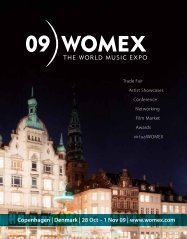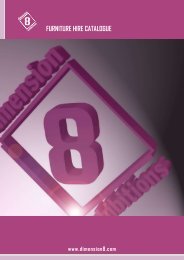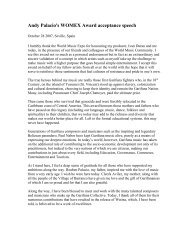WOMEX 11 Guide
WOMEX 11 Guide
WOMEX 11 Guide
You also want an ePaper? Increase the reach of your titles
YUMPU automatically turns print PDFs into web optimized ePapers that Google loves.
The World According to JaZZn e t w o r k© Joachým EttelJazz was the first world music, opined the renownedmusic promoter, Fritz Rau. Although the statementby the organiser of the seminal American FolkBlues Festivals (from 1962 to 1985) and founder ofthe German Jazz Federation may seem somewhatexorbitant, in a certain sense, he is right: jazz isidentified with and understood worldwide. It inspirespeople around the globe to incorporate it into theirown musical language, for jazz entices all to bringthemselves into it once they’ve been touched by thespirits of swing, groove and blue notes. The Americantrombonist George Lewis affirmed: “African-Americanmusic, like any music, can be performed, composed orconceived by a person of any ‘race’ without losing itscharacter as historically Afrological”.There’s no corner of this planet where people do notmusically improvise, experiment with rhythm andcreate songs. And jazz, after all, traces its origins tothe southern United States of the early 20 th century,with New Orleans as its centre, stemming directlyfrom the mixing of different cultural traditions of thepredominantly African-American population.Over its first five decades, jazz identified itself throughthe character of its main ingredients – spirituals, gospel,work songs, blues and ragtime – as a ‘social music’,a music that sought to communicate with its publicand initiate the interaction of body and spirit throughdance. In his book The Blues as Dance Music (1996), theculture and jazz historian Albert Murray ascribes dancea central role as a basis of Afro-American culture:“Dance not only antedates music, but is also probablythe most specific source of music and most of the artforms as well.” Dance music, according to Murray in histestimony to blues and jazz, has been underestimatedby critics and actually is of greater significance thanThe World According to JazzBy Joachým Ettel (Germany) | Freelance Journalist, Photographerconcert music. In the eyes of European jazz critics, forexample, blues has been downgraded over the last fewdecades to the status of a primitive forerunner of jazz.Afro-American musicians point out however, that the‘12-bar’ retains a perpetual claim as the eternal basis ofjazz. It was also jazz critics who formulated the imageof a progressive linear sequence of styles, a kind of jazzmusic evolution. But by the time it has completed itsdevelopment – from old time New Orleans throughDixieland, swing, hot jazz, bebop, West Coast cooljazz, East Coast hard bop, free, fusion and rock jazz,to modern and post-modern jazz – this Darwiniandesign becomes obsolete and history. For around 1970,the diversity of styles, and conflicting views of whetherthey can be called jazz or not, grew considerably. Thenarose the question: which of these new developmentscould be seen as trendsetting? From then on, therecould be no agreed recognition of a stylistic ‘follow-up’.As improvised music, jazz was always able to pick upinfluences from other cultural values. In this context,musicians from other ethnic traditions had theopportunity to express themselves without having tocompletely forego any input from their own culturalbackground, as was the case with other genres. In the1950s, jazz musicians began to make consolidatedefforts to deal with non-Western cultures. Projectsemerged in which musicians traced their African rootsas well as those that revealed Brazilian influences. Jazz,especially European jazz, was still dominated by theculture wars of the time. Rhythm and blues – malignedby the conservative jazz police as ‘jungle music’ – waspopular as never before, emerging from its bases inMemphis, Chicago, Dallas and New York as a separategenre, split off from jazz. The aesthetics and perceptionof jazz began to change. The music journalist HaraldJustin spoke of the beginning of an “expulsion ofrhythm and dance from jazz... And as the body and itsenergies could no longer find expression there, it foundits outlet in rhythm and blues and later, in rock”.In the ‘60s, the interest of many musicians in newspiritual experiences led to a strong interest in Indianand Asiatic music. In the jazz scene, it was above allJohn and Alice Coltrane who raised their soundsto hymn-like heights. Meanwhile European jazzemancipated itself more and more from its Americanrole models to develop art music qualities. A countermovement produced a backlash in the form of free jazz,providing a soundtrack for the social unrest of the endof the decade. Worldwide, musicians intensified therediscovery of their own traditions, using material fromtheir own folk music heritage and utilising regionalspecific instruments and blending the Afro-Americanjazz language with harmonic, melodic and rhythmicelements of their own culture.It was also in the ‘60s that the concept of ‘world music’came into being. It stood for a putative openness in theaesthetic sense and, in the time of the student rebellion,counted as part of the counter movement againstcultural imperialism. Although traditional musiciansdidn’t define their music as ‘art music’ in the Westernsense, they used the opportunity to present themselvesto a Western audience. Prominent examples from thistime were Ravi Shankar, Miriam Makeba and the newstars of Música Popular Brasileira. The German musicjournalist and producer, Joachim Ernst Behrendt,presented the record and concert series Jazz Meets theWorld, laying the foundation stone for the incipientworld music and ethno jazz wave, not only in Germany.Under his artistic direction the 1967 JazzFest Berlinbecame the first world music festival, intentionallyinitiating fruitful collaborations between jazz andtraditional musicians. For example, the pianist andlater director of the festival, George Gruntz, playedtogether with Jean Luc Ponty and Daniel Humairin combination with Bedouin musicians from theMahgreb, under the banner Noon in Tunisia.In the ‘70s, the initial idea of a meeting of cultureschanged into a fusion concept in which musiciansavailed themselves of all possible traditional influencesthat seemed interesting for their concept, to promotethe expansion of conventional modes of expression.New sounds should be developed, new formalstructures established. The result was an eclectic varietyof styles in which genre boundaries fell away. Next toclassical composition techniques, there appeared moreand more Indian rhythms, Arabic melisma and otherfolkloric traditions. An outstanding example of thisbeing the 1976 concept album, The Story of I, by PatrickMoraz, which put a whole conglomeration of clearlyidentifiable influences together from South Americanrhythms to progressive rock and neo-classical elementsinterwoven with jazz and pop.The ‘80s and ‘90s brought the final breakthrough,with the first ‘pure’ world music labels with worldwidedistribution, such as Peter Gabriel’s Real World, DavidByrne’s Luaka Bop and Nick Gold’s World Circuit.But to understand the increasingly close connectionsbetween jazz and world music and also the growingpresentation of important world music artists underthe umbrella of jazz, one must take another look atthe developments within jazz. The transition to bebopsignified the abandonment of social music to art music,with considerable consequences. The American essayistand culture critic, Michael Ventura, wrote in his bookShadow Dancing in the USA: “To play for dancing wasto focus on the listener. In this new jazz, for the firsttime, the focus was on the musician. Ideally the listenerlistened intently enough to join the improviser’s trance.That was understood as the listener’s job, the listener’sact of creation. That made possible a depth of thought– thought expressed musically but thought nonetheless– fully the equal of European musical thought, butwith the intensity, the rhythm and the constellationof meanings that had come out of Africa… Butthese musicians paid a price for the tremendousconcentration they achieved. They had largely left thedance behind. And leaving the dance behind, they’dleft the dancers. Not the dancing artists, who spent alltheir energy on their dances, but the rest of us, who,both knowingly and unconsciously, were still yearningfor the dance to take us up and return our bodies to ourhungering spirits. So it is no coincidence that the veryn e t w o r k The World According to JaZZ8283







